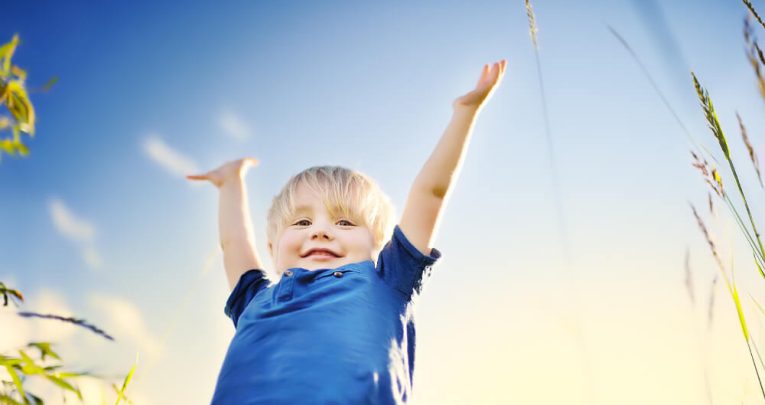7 Ways to Embrace Outdoor Learning and Play in Early Years this Autumn

There are huge advantages to escaping the classroom, however much space you have available beyond the door – so get messy, noisy, creative and active this season, says Kathy Brodie…

- by Kathy Brodie

One of the most profound aspects of being outside is the sense of wonder children can experience when investigating the magic of the natural world. This may be snow falling, or noticing how a dandelion changes from a yellow flower to white, fluffy seeds – or how strawberries grow from the heart of the flower. For adults these aren’t remarkable events, but it is worth remembering that, sometimes, it’s the simplest of natural changes that are most awe-inspiring to children.
What do you hear?
Outside, sounds are different, and music and singing can be more exuberant, giving children more opportunities to explore making different noises…
- Have metal saucepans, tin trays and large spoons hung from the fence for children to freely access whilst outside.
- Listen for environmental sounds together – e.g. the birds singing at different times of the day or the different types of traffic noises. This will help children to cue into specific sounds, an essential skill for distinguishing voices over background noises.
Kathy Brodie is an Early Years Professional and trainer based in East Cheshire.
Visit earlyyearssummit.com for lots more ideas on outdoor play and learning.
1 | A sensory feast
The most obvious benefit of being outside is that it is a full sensory experience. Children will experience hot and cold weather, smell flowers and plants, see many colours and feel varied textures, from sticks to mud. As the seasons change, the outside environment changes too. The autumn is particularly noticeable for the changes in the leaves – it may be the first time the children have noticed that their favourite tree is changing colour from day to day. At this time of year there may be more windy days, which can lead to conversations about weather we can feel but not see.
2 | Up and down
In most settings, the floor tends to be flat, even and on one level. However, outside children have to negotiate many different types of terrain and changing levels. Walking down a slope or climbing steps may be easily achieved, but greater challenges can be created by leaving some of the environment outside uneven, so children need to balance or walk with care. Rolling down slopes and spinning in circles on the spot also help to develop children’s vestibular systems.
3 | Creatures great & small
Outside is packed with mini-beasts, animals and birds, plants and flowers. This gives huge opportunities for sustained shared thinking and prolonged conversations about caring for living creatures, or even what constitutes being ‘alive’. For example, when is a stick a piece of living plant and when is it dead wood? Conversations like these help to foster compassion and caring for creatures. For some children, this may be an opportunity to discuss the nature of death as well. This is also a good time to explore sustainability and caring for our own environment.
4 | Special spaces
Due to the unstructured nature of being outside, it can offer many more informal social spaces, created by the children for themselves. For example, you may find that some children like to huddle together behind a tree or that under the climbing frame becomes the place to meet friends. These hideaways give children the opportunities to imagine and invent their own narratives around the space. One day it might be a spaceship, another day a bear’s cave!
5 | Creative play
Being outdoors is inspirational for many types of creativity and art, often using free and found materials. For example, leaves, stones, twigs and grass can be gathered to create pictures or 3D sculptures. Colours and paints look different in the changing natural light – even from morning to afternoon – and noticing the way that the sun streams through coloured glass to produce coloured patterns on the ground can be mesmerising.
6 | Glorious mud
Another great free material outside is mud. Mud kitchens are almost universal now, which is not surprising as they offer almost limitless opportunities for children to imagine, investigate and explore. Playing outside, where it doesn’t matter if anything is spilled, with such a versatile material allows children to be messy while practising all their pouring, tipping and mixing skills.
7 | A sense of wonder
One of the most profound aspects of being outside is the sense of wonder children can experience when investigating the magic of the natural world. This may be snow falling, or noticing how a dandelion changes from a yellow flower to white, fluffy seeds – or how strawberries grow from the heart of the flower. For adults these aren’t remarkable events, but it is worth remembering that, sometimes, it’s the simplest of natural changes that are most awe-inspiring to children.
What do you hear?
Outside, sounds are different, and music and singing can be more exuberant, giving children more opportunities to explore making different noises…
- Have metal saucepans, tin trays and large spoons hung from the fence for children to freely access whilst outside.
- Listen for environmental sounds together – e.g. the birds singing at different times of the day or the different types of traffic noises. This will help children to cue into specific sounds, an essential skill for distinguishing voices over background noises.
Kathy Brodie is an Early Years Professional and trainer based in East Cheshire.
Visit earlyyearssummit.com for lots more ideas on outdoor play and learning.











